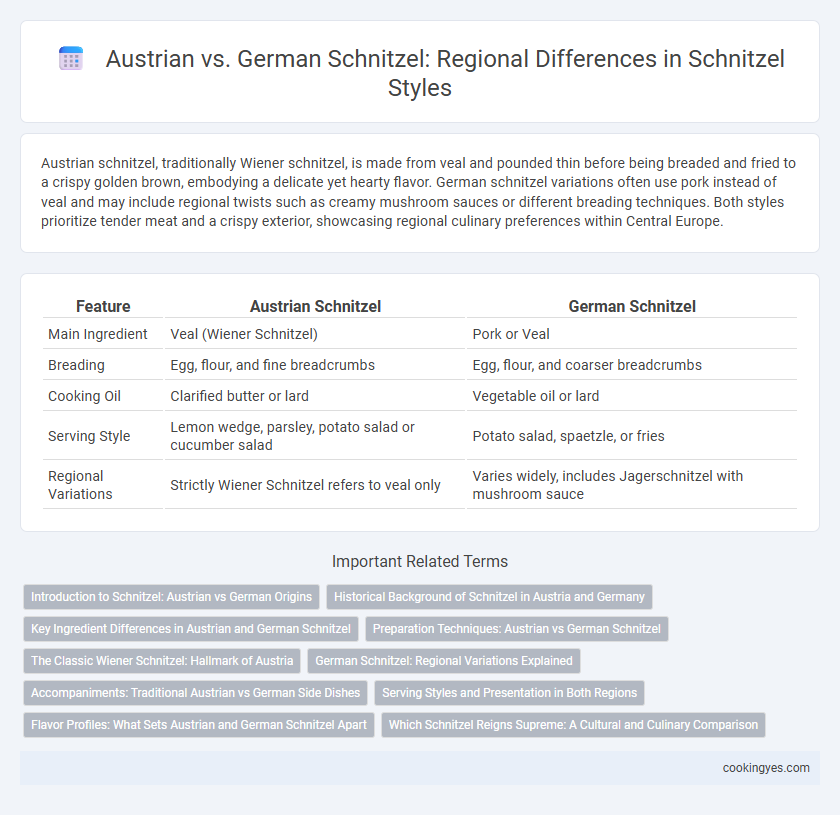Austrian schnitzel, traditionally Wiener schnitzel, is made from veal and pounded thin before being breaded and fried to a crispy golden brown, embodying a delicate yet hearty flavor. German schnitzel variations often use pork instead of veal and may include regional twists such as creamy mushroom sauces or different breading techniques. Both styles prioritize tender meat and a crispy exterior, showcasing regional culinary preferences within Central Europe.
Table of Comparison
| Feature | Austrian Schnitzel | German Schnitzel |
|---|---|---|
| Main Ingredient | Veal (Wiener Schnitzel) | Pork or Veal |
| Breading | Egg, flour, and fine breadcrumbs | Egg, flour, and coarser breadcrumbs |
| Cooking Oil | Clarified butter or lard | Vegetable oil or lard |
| Serving Style | Lemon wedge, parsley, potato salad or cucumber salad | Potato salad, spaetzle, or fries |
| Regional Variations | Strictly Wiener Schnitzel refers to veal only | Varies widely, includes Jagerschnitzel with mushroom sauce |
Introduction to Schnitzel: Austrian vs German Origins
Schnitzel, deeply rooted in both Austrian and German culinary traditions, exhibits distinct regional styles that reflect cultural nuances. The Austrian Wiener Schnitzel, made from veal and coated in a light breadcrumb crust, contrasts with the German variant often prepared with pork and accompanied by hearty side dishes. These differences highlight the diverse adaptations of schnitzel across Central Europe, emphasizing unique regional ingredients and preparation methods.
Historical Background of Schnitzel in Austria and Germany
Schnitzel tracing its roots to Austria, particularly Vienna, originated as "Wiener Schnitzel," a thin veal cutlet breaded and fried, gaining popularity in the 19th century during the Austro-Hungarian Empire. German regions adopted the dish, adapting it with pork instead of veal, reflecting local preferences and agricultural practices post-World War I when veal became less accessible. The historical divergence between Austrian and German schnitzel styles showcases regional culinary evolution driven by resource availability and cultural identity.
Key Ingredient Differences in Austrian and German Schnitzel
Austrian schnitzel, particularly Wiener Schnitzel, is traditionally made from veal, breaded with flour, egg, and fine breadcrumbs, emphasizing tenderness and a golden, crisp crust. In contrast, German schnitzel variants often use pork or sometimes turkey as the primary meat, with a slightly coarser breadcrumb coating that yields a heartier texture. The choice of meat and breadcrumb fineness distinctly influences the regional flavor profiles and authenticity of each schnitzel style.
Preparation Techniques: Austrian vs German Schnitzel
Austrian schnitzel, particularly the Wiener Schnitzel, is traditionally made from veal, pounded thin and breaded with a three-step coating of flour, beaten eggs, and fine breadcrumbs before frying in clarified butter for a delicate, crispy texture. German schnitzel varies more widely, often using pork instead of veal, and the preparation may include seasoning the meat before breading or incorporating different breadcrumb types, with frying typically done in oil or a butter-oil blend for a heartier crust. The Austrian method emphasizes lightness and subtle flavor, while German techniques focus on robust seasoning and versatile frying fats, reflecting regional culinary preferences.
The Classic Wiener Schnitzel: Hallmark of Austria
The Classic Wiener Schnitzel epitomizes Austrian culinary heritage, made exclusively from veal and coated in a delicate, golden breadcrumb crust. Unlike the German schnitzel, which varies widely and often uses pork, the Austrian Wiener Schnitzel adheres to strict regional standards protected under Austrian law, ensuring its authenticity. This iconic dish remains a symbol of Austria's precise culinary tradition, distinguishing it from the richer, more varied schnitzel interpretations found throughout Germany.
German Schnitzel: Regional Variations Explained
German schnitzel showcases diverse regional variations, with the iconic "Wiener Schnitzel" derived from Austrian cuisine but often adapted to local tastes using pork instead of veal. In Bavaria, the schnitzel is typically served with a rich mushroom sauce, while in northern Germany, variations like "Jagerschnitzel" feature a hearty hunter's sauce made from mushrooms and onions. These regional differences highlight the German preference for robust, flavorful accompaniments compared to the simpler, traditionally breaded and fried Austrian style.
Accompaniments: Traditional Austrian vs German Side Dishes
Traditional Austrian schnitzel is often served with potato salad made from vinegar and oil, lingonberry jam, and a slice of lemon, emphasizing a light and tangy flavor profile. German schnitzel accompaniments typically include creamy potato salad, red cabbage, and occasionally spaetzle, highlighting heartier, richer sides. These regional differences reflect Austria's preference for crisp, acidic contrasts and Germany's focus on comforting, robust flavors.
Serving Styles and Presentation in Both Regions
Austrian schnitzel, particularly the Wiener Schnitzel, is traditionally served with a lemon wedge, potato salad, or cucumber salad, emphasizing a delicate and crisp presentation. In contrast, German schnitzel often features a thicker cut and is accompanied by hearty sides such as fries, mashed potatoes, or sauerkraut, reflecting a more robust serving style. Both regions prioritize plating that showcases the golden, breaded exterior, but Austrian presentations lean towards minimalism while German servings highlight a generous, rustic appeal.
Flavor Profiles: What Sets Austrian and German Schnitzel Apart
Austrian schnitzel, particularly Wiener Schnitzel, is traditionally made from veal and features a light, crispy breadcrumb coating with a subtle, buttery flavor accentuated by lemon wedges. German schnitzel varieties, such as Jagerschnitzel, typically utilize pork and are served with robust mushroom gravy or creamy sauces, offering a richer, earthier taste profile. The key difference lies in the Austrian schnitzel's delicate, clean flavors versus the German versions' heartier, sauce-driven complexity.
Which Schnitzel Reigns Supreme: A Cultural and Culinary Comparison
Austrian Wiener Schnitzel, made exclusively from veal, features a delicate, thin breading and is typically served with lemon wedges and parsley potatoes, highlighting its refined tradition. In contrast, German Schnitzel often uses pork and includes variations like Jagerschnitzel with mushroom sauce or Zigeunerschnitzel with paprika sauce, reflecting regional diversity and heartier flavors. The Austrian Schnitzel reigns supreme in culinary prestige for its strict adherence to quality and simplicity, while German versions offer rich, varied taste profiles catering to broader palates.
Austrian vs German for schnitzel regional style Infographic

 cookingyes.com
cookingyes.com